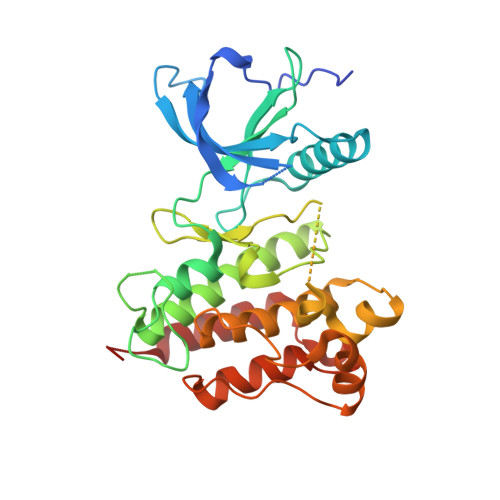TAS-120 Cancer Target Binding: Defining Reactivity and Revealing the First Fibroblast Growth Factor Receptor 1 (FGFR1) Irreversible Structure.
Kalyukina, M., Yosaatmadja, Y., Middleditch, M.J., Patterson, A.V., Smaill, J.B., Squire, C.J.(2019) ChemMedChem 14: 494-500
- PubMed: 30600916
- DOI: https://doi.org/10.1002/cmdc.201800719
- Primary Citation of Related Structures:
6MZQ, 6MZW - PubMed Abstract:
1-[(3S)-3-[4-Amino-3-[2-(3,5-dimethoxyphenyl)ethynyl]-1H-pyrazolo[3,4-d]pyrimidin-1-yl]-1-pyrrolidinyl]-2-propen-1-one (TAS-120) is an irreversible inhibitor of the fibroblast growth factor receptor (FGFR) family, and is currently under phase I/II clinical trials in patients with confirmed advanced metastatic solid tumours harbouring FGFR aberrations. This inhibitor specifically targets the P-loop of the FGFR tyrosine kinase domain, forming a covalent adduct with a cysteine side chain of the protein. Our mass spectrometry experiments characterise an exceptionally fast chemical reaction in forming the covalent complex. The structural basis of this reactivity is revealed by a sequence of three X-ray crystal structures: a free ligand structure, a reversible FGFR1 structure, and the first reported irreversible FGFR1 adduct structure. We hypothesise that the most significant reactivity feature of TAS-120 is its inherent ability to undertake conformational sampling of the FGFR P-loop. In designing novel covalent FGFR inhibitors, such a phenomenon presents an attractive strategy requiring appropriate positioning of an acrylamide group similarly to that of TAS-120.
Organizational Affiliation:
School of Biological Sciences, The University of Auckland, Private Bag 92019, Auckland, 1142, New Zealand.














